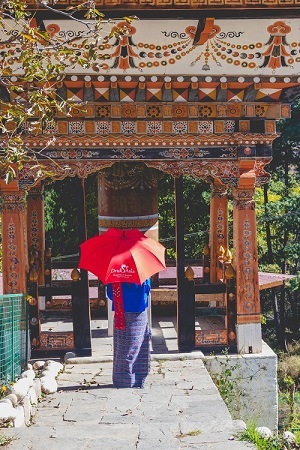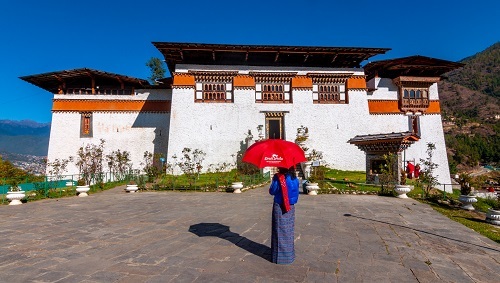Along the old road from Paro to Phuentsholing, about 5km south of Thimphu, lies the charming ancient fortress. Simtokha Dzong was built in 1629 by Zhabdrung Ngawang Namgyal. Strategically built on a projecting ridge with deep gullies, the Simtokha Dzong overlooks the entire Thimphu Valley.
Officially known as Sangak Zabdhon Phodrang ‘Palace of the Profound Meaning of Secret Mantras’. Simtokha Dzong is the first dzong built in Bhutan during the 17th century which is still intact in its original state. There were dzongs in Bhutan built as early as 1153, but this was the first dzong built by the Zhabdrung, and was the first structure to incorporate both monastic and administrative facilities. It is also the oldest dzong to have survived as a complete structure. Just above the dzong is Bhutan's Institute for Language and Culture Studies.

The present site where Simtokha Dzong stands is the boundary between three western regions: Sha (Wangduephodrang), Wang (Thimphu) and Pa (Paro). The intersection was marked with three stones that belong to the people of Punakha, Thimphu, and Paro. Surrounded by these three stones was a piece of land known as Sem-tokha or Sem-dokha with a temple built on it. This temple was later gifted to Zhabdrung by Lama Panka Song. A Tibetan Lama Zhang has prophesied that Zhabdrung Ngawang Namgyel would build a dzong at the junction of three western lands. To fulfill the prophecy and honor the offer of Lama Panka Song, Zhabdrung decided to build the dzong.
The area was inhabited by many demons, and legend has it that the site where Zhabdrung decided to build the dzong was occupied by a demon that would harm travellers who stayed overnight. Zhabdrung visited the place and subdued the demon, banishing her into the rock on the hill where the present dzong is located. The dzong was constructed enclosing the rock, to ensure the continuing imprisonment of the demon. Hence the dzong derived its name as Simtokha, from the word sunmo (demon), do (stomach) and kha (on) - the dzong on top of the demon’s stomach. During its construction Simtokha Dzong was attacked by an alliance of Tibetans and five Bhutanese lamas from rival Buddhist schools who were opposed to the Zhabdrung's rule. The attack was repelled and the leader of the coalition, Palden Lama, was killed. In 1630 the Tibetans attacked again and took the dzong, but the Zhabdrung regained control when the main building caught fire and the roof collapsed, killing the invaders.

The fortress was restored and expanded by the third desi (secular ruler), Mingyur Tenpa, in the 1670s, and it has been enlarged and modified many times since. The fine murals inside have been restored by experts from Japan.
Simtokha Dzong is built over 65 square feet and has a single entry point. There are three-storey all connected by stone steps while the lowest exterior has prayer wheels around the courtyard and 300 slate carvings that depict Buddhist masters and saints. The primary chapel houses the statue of Sakyamuni Buddha (Siddhartha Gautama) and the images of eight Bodhisattvas adjacent on both sides. The chapel is adorned by various murals which are considered very old. The chapel to the west has the image of Chenresig, and the wives of the Tibetan King Songsten Gampo, the White and Green Taras. You can also see an old painting depicting Shabdrung Ngawang Namgyal.
As you enter the dzong, there are murals of the four guardian kings – Vaishravana (north), Dhritarashtra (east), Virudhaka (south) and Virupaksha (west) – protecting the four cardinal directions, and the jewel-vomiting mongoose in the hand of the yellow King of the North. The dark murals inside this lhakhang are some of the oldest and most beautiful in Bhutan and the walls are adorned with embroidered thangkas (religious pictures).

